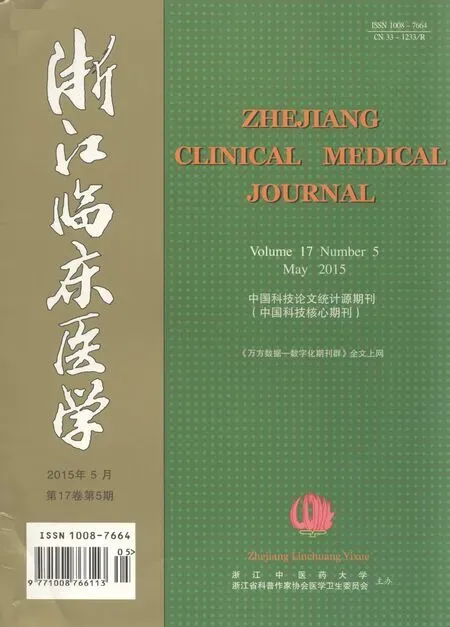主动脉夹层生物标记物的研究现状与最新进展
段旭洲 陈佳 徐志云⋆
·综述·
主动脉夹层生物标记物的研究现状与最新进展
段旭洲 陈佳 徐志云⋆
主动脉夹层是一种可引发多系统严重并发症的心血管急症。若未给予积极的临床干预,初期死亡率增加1%~2%/h,早期诊断和治疗对提高患者生存率有重要意义。在临床工作中,主动脉夹层的确诊耗时较长[1]。在欧洲,50%的患者确诊>6h,在美国>15h。75%的患者确诊需3~4h[2]。
1 相关生物标记物
准确迅速的诊断对降低主动脉夹层的死亡率和了解疾病的进展有重要意义。目前主动脉夹层诊断主要依赖影像学检查。而生化检测在临床中扮演了越来越重要的角色。理想的生物标记物需具备以下特点:低成本,能在临床上广泛应用,检测相对简单迅速,具有高度敏感性、特异性。目前尚无夹层相关生物标记物完全符合上述特点,但生物标记物的运用仍为夹层的诊断及鉴别诊断提供重要依据。
主动脉夹层是由于在主动脉中层发生撕裂后,血液在撕裂层中流动,导致血管壁分层[3]。生物标记物可反映血管平滑肌(smMHC)损伤、血管间质损伤(钙调节蛋白)、细胞外基质(MMP-9)的降解。由于主动脉假腔中血流动力学的改变、内皮细胞的暴露等,导致纤溶系统异常。近年来的研究均表明炎症反应在主动脉夹层的发生发展中扮演了重要的角色[C反应蛋白(CRP)、白介素-6(IL-6)]。本文通过对现有研究进行全面系统分析,以探讨各种生物标记物在主动脉夹层发生进展中的作用。
1.1 smMHC 平滑肌肌球蛋白是平滑肌的重要组成部分,当夹层形成时,由于血管平滑肌损伤,导致smMHC扩散至血液循环中。Katoh等发现smMHC在急性主动脉夹层最初的24h内迅速上升[4]。Suzuki等发现急性主动脉夹层患者血液中smMHC水平明显上升,并在发病后3h达到峰值[5]。由于腹主动脉平滑肌较少,夹层发生时smMHC释放较胸主动脉少,可能对病变在主动脉近端或远端有提示作用[6]。SmMHC的检测仅需30min,对急性主动脉夹层的鉴别诊断、病情评估具有潜在价值。smMHC的检测亦存在局限性,当含有血管平滑肌的器官出现病变时,其在血清中的水平亦会明显上升,仍需要大量的随机试验,才能广泛的运用到临床。1.2 钙调节蛋白 钙调节蛋白是血管壁中的结构蛋白,具有收缩和舒张功能,当发生主动脉夹层时,在炎性反应和蛋白水解酶的作用下,导致主动脉中膜的可溶性钙调节蛋白碎片进入血液循环。钙调节蛋白有三种亚型:碱性、酸性、中性。Toru Suzuki等发现酸性和碱性的钙调节蛋白水平,在主动脉夹层发病后6h和12h明显上升。而中性亚型的钙调节蛋白水平未明显上升[7]。在夹层发生12h之后,与smMHC相比,钙调节蛋白具有更高的诊断价值。
1.3 MMP-9 MMP-9可用作不典型主动脉夹层(AAD)早期诊断的标志物。Karapanagiotidis等发现慢性主动脉夹层患者血清中MMP-9水平明显升高[8]。慢性主动脉夹层患者MMP-9水平的上升与患者的年龄和高血压病史有关[9]。国外近年来的研究表明MMPs在许多心血管疾病中过度表达,Kurihara T等以小鼠为模型,发现富含MMP-9的免疫细胞在夹层组中的计数明显高于非夹层组[10]。Koullias等通过对主动脉病变组织进行免疫组化分析,发现胸主动脉瘤和主动脉夹层患者的MMP-9表达明显高于健康者,而主动脉夹层患者又明显高于主动脉瘤患者[11]。
1.4 D二聚体 D二聚体主要反映纤维蛋白溶解功能,在主动脉夹层中,假腔中血流动力学发生改变,同时组织在假腔中暴露,导致纤溶蛋白的激活,引发D二聚体水平上升。D二聚体对急慢性夹层的鉴别具有重要意义[12]。D二聚体既可作为早期诊断的指标,又可作为排除诊断的标准。D二聚体临界值水平在不同报道中各不相同。Akutsu K等对78例患者评估(30名急性主动脉夹层、48例非主动脉夹层),D二聚体以0.50μg/ml为临界水平,其敏感性为100%,特异性为54%[13]。Thomas Weber等发现所有急性夹层患者D二聚体水平均>0.50μg/ml[14]。Peiman Nazerian等对1035名疑似主动脉夹层的患者进行统计,D二聚体取500μg/μl为临界值,同时利用回顾性图表分析对疑似患者进行风险评分。主动脉夹层患者D二聚体敏感性为100%[15]。血清中D二聚体水平<0.50μg/ml可排除急性主动脉夹层[16]。D二聚体水平不但在急性主动脉夹层发生后24h急剧上升,而且持续至发病后10d[17]。D二聚体>5.67μg/ml是急性主动脉夹层院内死亡的独立因素[18]。急性主动脉夹层患者血清D二聚体水平明显高于慢性主动脉夹层、急性心肌梗死、非心源性胸痛的患者,但需要与肺栓塞相鉴别[19]。
1.5 CRP和hs-CRP 血清CRP水平是临床上常用的非特异性炎性反应标记物,它不仅反映血管炎症,同时还可体现全身炎性反应。hs-CRP采用了超敏感检测技术,能更加准确检测浓度。CRP直接参与了炎性反应[20],其水平上升可能与主动脉夹层撕裂程度和夹层的进展息息相关[21]。有报道称CRP≥12.05 mg/L是急性主动脉夹层患者入院死亡率的高危指标[22]。血清CRP水平>15 mg/L是术前氧合损伤和预后效果不佳的危险系数[23]。Yuan SM等研究发现hs-CRP水平在急性 A型夹层患者中高于慢性主动脉病变患者和健康者[24]。Kenichi Sakakura等对232例急性主动脉夹层(stanford B型)患者研究表明,血清CRP峰值水平的时间为(4.5±1.7)d,其峰值水平是病情严重程度的重要体现[25]。CRP水平持续升高或者下降后再次上升提示需复查CT或MRI,同时需要更加严格控制血压和尽早行手术治疗[26]。
1.6 IL-6 IL-6是重要的炎性细胞因子,其基因表达和分泌的异常可导致多种疾病的发生和发展。近年来,IL-6引起心血管相关学科的广泛关注,IL-6在急性炎性反应、免疫应答中发挥作用。Dan Wen等对64例急性主动脉夹层患者,42例慢性夹层患者,98例仅患有原发性高血压患者,96例健康人员进行分析,发现急性主动脉夹层患者中血浆IL-6水平显著高于高血压组和健康组[27]。同时,IL-6基因表达调控不仅为主动脉夹层的发病机制提供了信息,亦为诊断和治疗开辟了新的途径。
2 存在的问题
(1)各中心对主动脉夹层患者的研究均存在样本量局限的问题,对明确生物标记物与夹层的发生、进展、转归、预后的关系,仍需要庞大样本数量。(2)现有研究是以确诊的患者为对象进行回顾性研究。而主动脉夹层需要早期诊断和干预,所以需进行前瞻性研究,改善患者的预后。(3)对许多生物标记物的研究还停留在动物模型水平,运用于临床工作还需要进一步探索。(4)有些生物标记物的检测相对复杂,需要时间较长,其临床意义明显受到限制。
3 小结
综上所述,各种生物因子在主动脉夹层发生、发展、转归中伴有重要角色。生物标记物的检测简单易行,应用方便,对主动脉夹层诊断、鉴别诊断、治疗、预后的评估有重要临床意义。但目前依旧存在局限性,仍有待于多中心、大样本的随机对照试验提供可靠的循证医学证据。
1 Rapezzi C,Longhi S,Graziosi M,et al.Risk factors for diagnostic delay in acute aortic dissection.Am J Cardiol,2008,102(10):1399~1406.
2 Raghupathy A,Nienaber CA,Harris KM,et al.Geographic differences in clinical presentation,treatment,and outcomes in type A acute aortic dissection(from the International Registry of Acute Aortic Dissection). Am J Cardiol,2008,102(11): 1562~1566.
3 Menon A,Garg AA,Rai S,et al.Management of acute Type A aortic dissection.Med J Armed Forces India,2014,70(1):73~75.
4 Katoh H,Suzuk i T,Hiroi Y,et al.Diagnosis of aortic dissection by immunoassay for circulating smooth muscle myosin.Lancet,1995, 345(8943):191~192.
5 Su zuki T,Katoh H,Tsuchio Y,et al.Diagnostic implications of elevated levels of smooth-muscle myosin heavy-chain protein in acute aortic dissection.The smooth muscle myosin heavy chain study.Ann Intern Med,2000,133(7):537~541.
6 Caprini JA,Glase CJ,A nderson CB,et al.Laboratory markers in the diagnosis of venous thromboembolism.Circulation,2004,109(Suppl 1 12):14~18.
7 Suzuki T,Distante A,Zizza A,et al.Preliminary experience with the smooth muscle troponin-like protein,calponin,as a novel biomarker for diagnosing acute aortic dissection.Eur Heart J,2008,29(11):1439~1445.
8 Karapanagiotidis GT,Antonitsis P,Charokopos N,et al.Serum levels of matrix metalloproteinases -1,-2,-3 and -9 in thoracic aortic diseases and acute myocardial ischemi a.J Cardiothorac Surg,2009,4:1~6.
9 Zhang X,Wu D,Choi JC,et al.Matrix metalloproteinase levels in chronic thoracic aortic dissection.J Surg Res,2014,189(2):348~358.
10 Kurihara T,Shimizu-Hirota R,Shimoda M,et al.Neutrophil-derived matrix metalloproteinase 9 triggers acute aortic dissection.Circulation, 2012, 126(25): 3070~3080.
11 Koullias GJ,Ravic handran P,Korkolis DP,et al.Elefteriades JA.Increased tissue microarray matrix metalloproteinase expression favors proteolysis in thoracic aortic aneurysms and dissections. The Annals of thoracic surger y, 2004,78(6): 2106~2110.
12 Sbarouni E,Georgiadou P,Marathias A,et al.D-dimer and BNP levels in acute aortic dissection .Int J Cardiol,2007,122(2):170~172.
13 Akutsu K,Sato N,Yamamoto T,et al.A rapid bedside D-dimer assay(cardiac D-dimer)for screening of clinically suspected acute ao rtic dissection.Circ J,2005,69(4): 397~403.
14 Thomas Weber M,Högler S,Auer J,et al.D-dimer in Acute Aortic Dissection.CHEST,2003,123(5):1375~1378.
15 Nazerian P,Morello F,Vanni S,et al.Combined use of aortic dissection detection risk score and D-dimer in the diagnostic workup of suspected acute aortic dissection.Int J Cardiol,2014,175(1):78~82.
16 Shimony A,Filion KB,Mottillo S,e t al. Meta-analysis of usefulness of d-dimer to diagnose acute aortic dissection. Am J Cardiol,2011, 107(8):1227~1234.
17 Albini P,Barshes NR,Russell L,et al.D-dimer levels rema in elevated in acute aortic dissection after 24 h.Journal of Surgical Research,2014,191(1): 58~63.
18 Wen D,Du X,Dong JZ,et al.Value of D-dimer and C reactive protein in predicting inhospital death in acute aortic dissection. Heart,2013,99(16):1192~1197.
19 Eggebrecht H,Naber CK,Bruch C,et al.Value of plas ma fibrin D-dimers for detection of acute aortic dissection.J Am Coll Cardiol,2004,44(4):804~809.
20 Li JJ,CH Fang.C-reactive protein is not only an infl ammatory marker but also a direct cause of cardiovascular diseases.Medical Hypotheses,2004,62(4):499~506.
21 Kuehl H,Eggebrecht H,Boes T,et al.Detection of inflammation in patients with acute aortic syndrome: comparison of FDGPET/CT imaging and serological markers of inflammation. Heart,2008,94(11):1472~1477.
22 Wen D,Wu HY,Jiang XJ,et al.Role of plasma C-reactive protein and white blood cell count in predicting in-hospital clinical events of acute type A aort ic dissection.Chin Med J(Engl),2011,124(17):2678~2682.
23 Sugano Y,Anzai T,Yoshikawa T,et al.Serum C-reactive protein elevation predicts poor clinical outcome in patients with distal type acute aortic dissection: association with the occurrence of oxygenation impairment.International Journal of Cardiology,2005,102(1):39~45.
24 Yuan SM,Shi YH,Wang JJ,et al.Elevated plasma D-dimer and hypersensitive C-reactive protein levels may indicate aortic disorders. Rev Bras Cir Cardiovasc,2011,26(4):573~581.
25 Sakakura K,Kubo N,Ako J,et al.Peak C-reactive protein level predicts lo ng-term outcomes in type B acute aortic dissection.Hypertensi on,2010,55(2):422~429.
26 Okina N,Ohuchida M,Takeuchi T,et al.Utility of measuring C-reactive protein for prediction of in-hospital events in patients with acute aortic dissection. Heart Vessels,2013, 28(3): 330~335.
27 Wen D, Zhou XL, Li JJ, et al. Plasma concentrations of interleukin-6,C-reactive protein, tumor necrosis factor-alpha and matrix metalloproteinase-9 in aortic dissection. Clin Chim Acta, 2012, 413(1~2): 198~202.
国家高技术研究发展计划(863计划)(2009AA02Z401)
200433第二军医大学长海医院胸心外科(段旭洲 徐志云)
200003 第二军医大学长征医院心内科(陈佳)
*通讯作者

